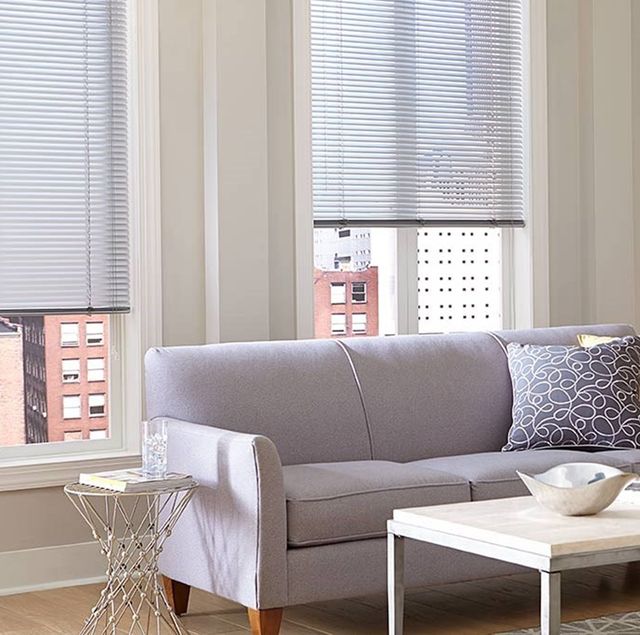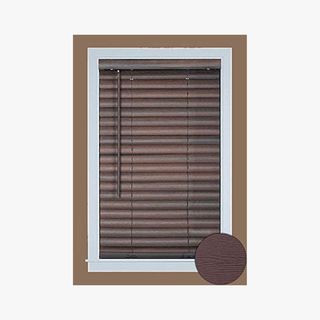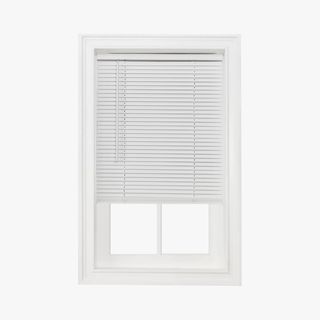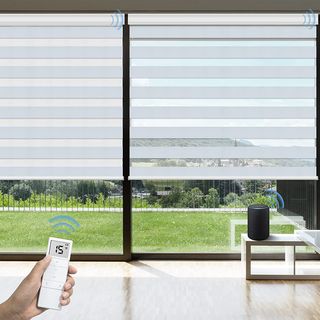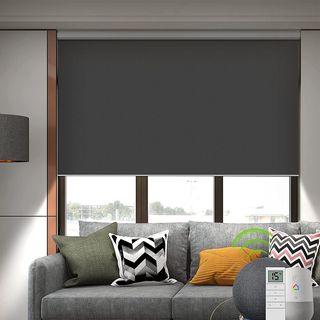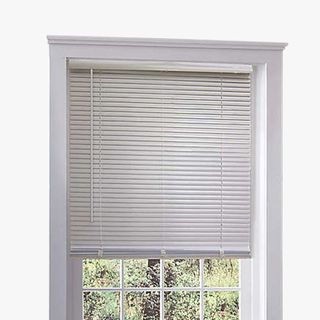It’s time for us to shed some light on blinds. Meant to filter and insulate, blinds are typically defined as horizontal or vertical slats made of metal, plastic and/or occasionally fabric that are used for windows, doors, and rooms. If you have the budget for it, you can order custom blinds that are specially made to fit your space. Often, though, ready-made blinds work fine for standard windows and doors, and come at a better price. You do you, though. It all depends on what you need.
How big are your windows? What color is the room? Are you trying to shield it from the sun, cold or nosy neighbors? When shopping, be sure to consider what fits in your space, how much you want to spend and what materials you like. Also insulation, light filtering, and size. We understand that it can get complicated.
Start your search here. From cellular shades to micro blinds, we’ve gone into the different types of blinds and which ones are probably right for you.
Venetian Blinds
The most popular, Venetian blinds are horizontal slats made of metal, wood or plastic that you can tilt up to 180 degrees to allow for more or less light, as needed. Modern types are also cordless, which are generally preferable for families with pets and/or young children. (Cordless means tangle-free. Also, strangle-free.)

Achim Cordless Luna 2-Inch Vinyl Plantation Blinds
PowerSellerUSA
amazon.com
$30.48
Ideal for families, the Cordless Luna Plantation Blinds are water-proof and resistant to chips, and all you need to do to use them is tilt, lift or lower the bottom rail. These blinds have 2-inch vinyl slats and a 2-inch attached valance.
Amazon

Cordless White Faux Wood Blinds
Allen + Roth
lowes.com
$42.98
Privacy and light filtering galore with these cordless 2-inch faux wood blinds. The textured finish is resistant to moisture, which makes it great for a place with high humidity.
Lowe's

Amancer Light Filtering Blinds with Slats
This venetian blind is made of PVC for durability and designed for indoor residential use. It has a semi-sheer light filtration, and can be raised or lowered by the bottom rail and tilted via wand.
Wayfair
Mini Blinds
Similar to Venetian but shorter and often made of metal are the mini blinds. Another variety is the even smaller micro blind, which has slats that are about half an inch thick.

Morningstar 1-Inch Mini Blinds
Achim Home Furnishings
amazon.com
These 27-inch wide blinds are pearl white and made of vinyl with an inside mount. They come with a button to lower or lift the blinds as well as a tilt wand for light filtering.
Amazon

Irondale Mini Blinds
Charlton Home
wayfair.com
$29.99
Room-darkening and custom fit to your windows, these synthetic cordless blinds have a straightforward installment. It just takes a bit of extra strength to get the blinds into the bracket.
Wayfair

1-Inch Aluminum Mini Blinds
Custom Home Collection
homedepot.com
$21.50
Privacy-giving and light-filtering abound with these cordless 1-inch mini blinds. There are plenty of colors to choose from, like deep green Pine and neutral beige Driftwood.
Home Depot
Vertical Blinds
Ideal for glass doors and large windows, these tiltable vertical floor-to-ceiling slats typically come in vinyl or fabric. Make sure you don’t measure the length of slats you need until you’ve put in the track on your ceiling, unless you would like your blinds to drag on the floor.

Tim+Go Vertical Blinds
This 13-pack of 3.5-inch x 84-inch white plastic slats can darken the room as desired, and comes with same-day sizing at your local Lowe’s so the slats can be trimmed to your window’s width.
Lowe's

Curved Vinyl Vertical Blinds
Bali
homedepot.com
$52.63
Choose from a bunch of different colors and textures with this highly-rated set available at Home Depot. Ideal for those who want to dress up their window treatments, you can operate these with a chain and cord and with a tilt wand.
Home Depot

Blackout White Vertical Blinds
Winston Porter
wayfair.com
$195.99
Blackout curtains are great for bedrooms, rooms with expensive furniture and home theaters where you need ultimate light filtering and protection from the sun. These are a good choice if you have a sliding door or a window wall.
Wayfair
Panel Blinds
Similar to vertical blinds, panel blinds are made with fabric and hang vertically, and work well as room dividers in addition to window treatments. They don’t typically tilt, which makes them more of an all-or-nothing option when it comes to filtering light.

Adjustable Sliding Panel Track Blinds
Symple Stuff
wayfair.com
$178.99
A woven blend of paper and polyester in a semi-sheer off-white gives these panel blinds a minimalist look that can balance out a bright room. This option comes with a wand to slide the blinds to the right or left.
Wayfair

Diamond Silver Light Filtering Window Panel Track
Godear Design
homedepot.com
$149.99
This adjustable 4-rail track and easy-to-trim 23-inch panel set is made of woven fabric and subtle cup sequins.
Home Depot

Sliding Panel Blinds
Chicology
amazon.com
$124.99
$100.39 (20% off)
Best for sliding doors, these vertical panels are an alternative to drapes or curtains. You can also use them as a room divider or to cover storage.
Amazon
Motorized Blinds
On the pricier side, motorized blinds can be connected to a smart home assistant like Amazon’s Alexa or Apple’s Siri, and controlled by remote, voice or an app on your phone. These are well-suited for those with disabilities who may not be able to operate corded blinds. Also, they look cool, which makes them for everybody.

Motorized Zebra Sheer Blinds
Graywind
amazon.com
$189.99
These white 4.5-inch blinds are compatible with Alexa and similar devices. The tilting and raising functions are powered by a lithium battery motor that you can recharge.
Amazon

Motorized Cellular Shade
Allen + Roth
lowes.com
$99.00
Made of recycled polyester, the white blackout shade can be used up to 400 times on one charge. It comes with a remote control, which is handy for windows that might be hard to reach.
Lowe's

Motorized Smart Blinds
Yoolax
amazon.com
$169.00
This vinyl option is operable by smart home assistant or remote control. If the standard sizes don’t work for you, you can customize your order.
Amazon
Aluminum Blinds
Meant for sunny rooms for their ability to repel heat, these blinds look their best in a living room or bedroom. The slats are usually a 6- or 8-gauge aluminum, and come in widths of ½-inch to 2-inch.

Heritage 2-Inch Aluminum Blinds
Bali
homedepot.com
$48.10
Coming in whites and neutrals, the retro-style 2-inch blinds go well in any room. These raise and lower with a cord, and you can choose a wand or cord for tilting.
Home Depot

Aluminum Cordless Blinds
Home Collection
bedbathandbeyond.com
$64.99
Breeze-softening and light-filtering, these aluminum blinds need only an occasional spot clean for maintenance.
Bed, Bath & Beyond

Add-On Blinds
Install this set on your current glass door frame and attach it to the door itself. With narrow slats and cordless operation, these enclosed blinds can be raised, lowered and tilted by hand.
Lowe's
Rolling Blinds
Unlike stacked slats of other blinds, the rolling blinds unroll from a spool that you attach to the top of your window. Many are made to keep heat in and cold out, making them well-suited for any windows exposed to wind or that face the sun.

Dual Layer Zebra Roller Window Blinds
ShadesU
amazon.com
$65.00
This corded zebra window shade alternates sheer and opaque fabric slats to allow for privacy and for light. Widths for the panels range from 20 inches to 110 inches.
Amazon

Veranda 1/4-inch Vinyl Roll-up Blinds
Cordless quarter-inch oval slats give you gently-filtered light as well as a good amount of privacy. Fasteners are used to secure the blinds, which can be rolled in either direction and used indoors or out.
Lowe's

Bamboo Roller Shade
TJ Global
amazon.com
$25.99
Easy to install and with minimal light allowed through, this product is a good option for those who want to see through their shades. The pulley and hardware can be seen upon installation, and the shade is apparently sensitive to rainwater, but the vast majority of reviewers say that it’s well worth it for the look and the price.
Amazon
Outdoor Blinds
With outdoor blinds, the slats are closer together and made of tough stuff to last hours in the rain, snow and sun. Often you’ll find these made of woodgrain or reed, used for a porch or any other exterior.

Cord-Free PVC Roll Up Blinds
Radiance
amazon.com
$35.98
Measuring 72 inches by 72 inches, these PVC blinds have a UV rating of 80 percent—perfect for protection from the sun. Handroll and clip to the length you want and you’re good to go.
Amazon

Bamboo Flat-Weave Roll Up Blinds
Seta Direct
amazon.com
$95.99
The bamboo slats in these roll-up blinds overlap each other a little bit in order to really reduce that gap in-between and keep out as much light as possible. Instead of a valance, there’s a roller pulley with basic hardware included.
Amazon

Solar-Powered Motorized Easy Shade
SunSetter
wayfair.com
$981.61
Though clearly an investment, this solar-powered window treatment is convenient and cost-saving in that it doesn’t need to be plugged in or be exposed to direct sunlight to maintain its charge. Good for upper-level windows, the synthetic fabric panel can be controlled with a remote control.
Wayfair
Cellular Shades
Made of spun polyester, these flexible, honeycomb-shaped shades come in single, double and triple combs that can trap air and boost your temperature control.

Honeycomb Blackout Cellular Shade
Mistana
wayfair.com
$57.07
Polyester keeps the light out and the cordless honeycomb build makes it easy to use. The off-white shade helps it to blend in any room.
Wayfair

Cordless Cellular 48-Inch Shade
Real Simple
bedbathandbeyond.com
This lightweight option comes with semi-sheer fabric that strikes a balance between allowing light in and maintaining privacy.
Bed, Bath & Beyond

Light Filtering Cordless Cellular Shade
Home Decorators Collection
homedepot.com
$69.70
Diffused natural light coupled with insulation from the polyester and honeycomb make this an ideal choice; as a fun bonus, it comes in both neutral and bold hues.
Home Depot
